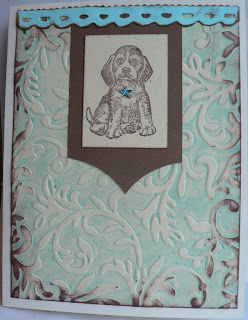I re read the book, the authors state that the effect of this technique is more dramatic on a slick surface than on a porous one. Now I see, last time I did the technique on a gesso primed canvas. This time I used watercolor paper. That explains it. (I'm better at looking at pictures than reading all the instructions)
If desired, paint surface first with acrylic paint and let dry (I used marigold acrylic paint). Use a thin coat of diluted paint or liquid acrylic over the surface:
Then drop rubbing alcohol on to the surface. You can use a dropper or a toothbrush or a q-tip or in a spray bottle (I'm not sure of the safety of vaporizing the alcohol, so I didn't try that). On the sample on the left, in the time I quickly took the photo above and then dropped on the alcohol, the paint was not wet enough to show well. The sample on the right was done the same, but I didn't stop to take a photo. You can see how the paint begins to form pools and reveal the paint underneath.
When dry:
Tried doing another layer. Painted a mixture of watered down q. nickel azo gold and brown acrylic paint, then dropped on the rubbing alcohol.
Here's my result.
Also, tried this technique with Lumiere (a metallic acrylic paint) over a red painted watercolor paper. When I dropped on the rubbing alcohol, it seem to just lift off the Lumiere paint, not to create the pooling of paint as the above samples.
The authors say that a really wet paint will give slightly wavy circles and a drier paint will give sharper edges. I'm thinking I used too thick of a layer of paint here.
To see better results of this technique where I flicked on rubbing alcohol with my finger and with a toothbrush check out
this post.



















































